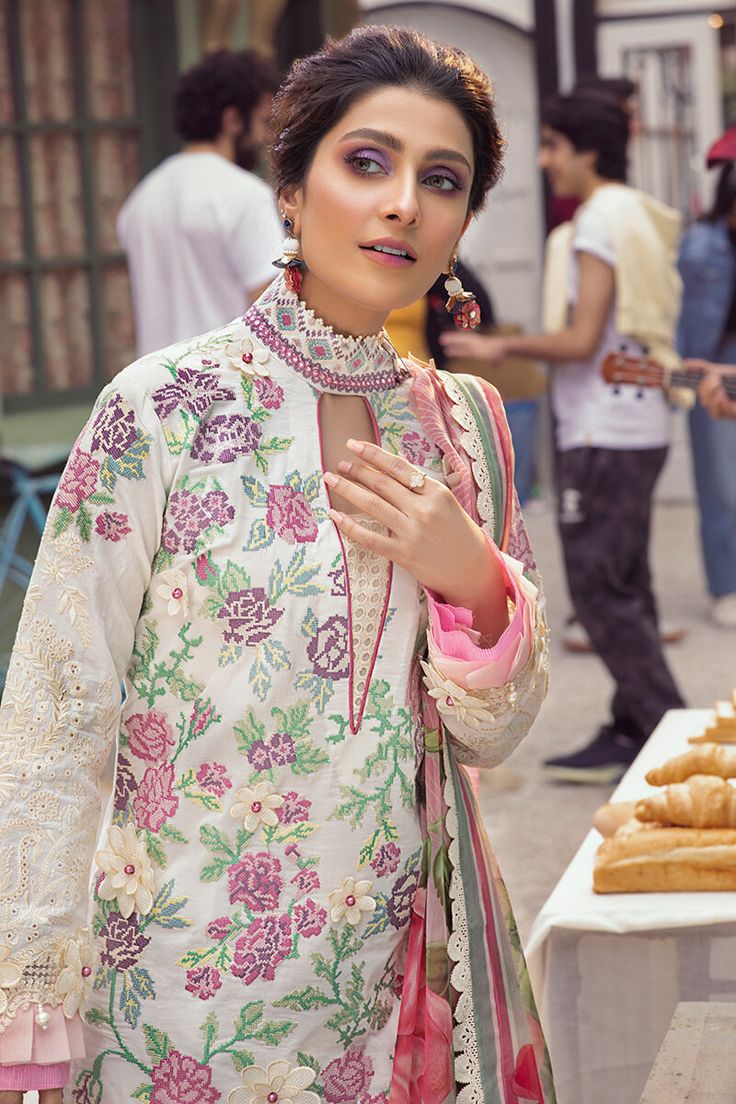Stitching your own Salwar Kameez can be an exciting and fulfilling endeavor, especially when you're equipped with the right guidance and resources! In this comprehensive guide, we'll walk you through the various aspects of creating your own Salwar Kameez, from understanding the fabric to mastering the stitching techniques. Plus, we have selected some fantastic Dailymotion videos to visually guide you throughout this journey. Let's embrace the art of tailoring and dive into the world of traditional Indian attire!
Understanding the Salwar Kameez

The Salwar Kameez is not just a piece of clothing; it's a cultural emblem in many parts of South Asia, especially in India and Pakistan. This traditional outfit combines comfort with elegance, making it a popular choice for women of all ages. Let’s break down the components and essential features of the Salwar Kameez to help you get started.
Components of Salwar Kameez:
- Kameez: This is the long tunic that covers the body. It can be styled in various lengths and designs—ranging from knee-length to floor-length. The pattern can be straight-cut, A-line, or even flared, depending on your preference.
- Salwar: These are the loose-fitting trousers that accompany the kameez. You can opt for traditional pleated salwar or modern styles like churidars or palazzos, which provide a contemporary twist to the outfit.
- Dupatta: A long scarf or shawl, often richly designed, that can be draped over the shoulders or head. The dupatta adds an elegant touch, elevating the overall look.
Fabric Choice: The choice of fabric plays a crucial role in the drape and overall look of the Salwar Kameez. Popular options include:
| Fabric | Style Suitability | Season |
|---|---|---|
| Cotton | Casual and Daily Wear | Summer |
| Silk | Festive and Ethnic Wear | Winter |
| Georgette | Party Wear | All Seasons |
| Chiffon | Elegant Drapes | All Seasons |
By understanding these components and fabric options, you're well on your way to crafting a stunning Salwar Kameez that resonates with your style preferences. So, gather your materials, and let’s get ready to stitch!
Also Read This: Effortlessly Open Your iPhone 3GS with Dailymotion Video Guidance
3. Materials Required for Stitching

Stitching a beautiful salwar kameez involves more than just a sewing machine and scissors. Having the right materials at your disposal is crucial for achieving that perfect fit and finish. Here’s a handy list of essentials you'll need:
- Fabric: The main ingredient! Depending on the season and occasion, you can choose from materials like cotton, silk, chiffon, or georgette.
- Thread: Choose a thread that matches your fabric color. Regular polyester threads work well for most fabrics.
- Sewing Machine: A reliable sewing machine is essential. If you’re just starting, a simple, user-friendly model will do the trick.
- Scissors: Invest in a good pair of fabric scissors. They make all the difference! Avoid using your kitchen scissors.
- Measuring Tape: Accurate measurements are a must! A flexible measuring tape will be your best friend.
- Pins and Clamps: Use these to secure fabric pieces together before stitching. Pins are great, but fabric clips can be easier for thicker materials.
- Ruler and Chalk: For marking measurements and cutting lines, a ruler and tailors’ chalk will come in handy.
- Iron: Keep your fabrics wrinkle-free. An iron helps in pressing seams open for a crisp finish.
- Pattern Paper: If you're making a custom design, you might want to draft your own patterns on this paper.
With these materials at hand, you'll be ready for your stitching journey. Don’t worry if you don’t have everything right away; the process is all about building your toolkit over time!
Also Read This: How to Contact Other Users on Dailymotion
4. Choosing the Right Fabric

When it comes to stitching a stunning salwar kameez, selecting the right fabric is critical. The fabric not only affects the look and feel of the outfit but also influences how well it drapes and fits. Here are some tips to help you choose wisely:
- Consider the Occasion: Think about where you'll wear your salwar kameez. For daily wear, cotton is a comfortable choice, while silk can be perfect for weddings and festivities.
- Seasonal Fabrics: Choose lightweight fabrics like chiffon or georgette for summer, while warmer fabrics such as velvet or silk are more suitable for winter.
- Go for Comfort: Always prioritize comfort. Soft, breathable fabrics like cotton are great, especially if you’re wearing the outfit all day.
- Patterns and Prints: Choose fabrics that reflect your personal style. Bold prints grab attention, while subtle patterns offer an elegant touch.
- Quality Matters: Don’t skimp where it counts! Higher-quality fabrics will not only look better but also last longer.
Remember, the fabric you choose sets the tone for your entire outfit, so take some time to explore your options. A well-chosen fabric can transform your salwar kameez into a stunning masterpiece!
Also Read This: Is OK RU Safe? Here is What You Need to Know
5. Measure and Cut the Fabric

Before diving into the fun part of stitching your Salwar Kameez, it's crucial to get your measurements and fabric cutting just right. This step is like setting the foundation of a house; without it, everything else might just crumble. So, let’s break it down!
First things first, you’ll need to gather your measuring tools: a measuring tape, fabric chalk or marker, and a pair of sharp fabric scissors. Next, follow these steps:
- Take Accurate Measurements: Measure the following key areas:
- Bust: Measure around the fullest part of your bust.
- Waist: Wrap the measuring tape around your natural waistline.
- Hip: Measure around the fullest part of your hips.
- Length: Decide how long you want the kameez and measure from your shoulder to that length.
- Add Seam Allowance: Always remember to add about 1 inch of seam allowance to all measurements. This extra fabric will be vital for sewing the pieces together!
- Cut the Fabric: Lay your fabric flat on a clean surface. Using your fabric chalk, mark the measurements you recorded. Cut carefully along the lines, ensuring you keep your cuts even and straight.
Remember, measure twice, cut once! Taking your time here will save you a lot of headaches down the line. Once you’ve got your pieces ready, you’re all set to move on to the exciting part - stitching!
Also Read This: List of Top Startups on LinkedIn from USA in 2023
6. Stitching Techniques Explained
Now that you have your fabric pieces neatly cut, it's time to put them together! Understanding various stitching techniques is essential for sewing a beautiful Salwar Kameez. Here are some fundamental techniques to get you started:
| Technique | Description |
|---|---|
| Running Stitch | A basic stitch that involves making a series of small, even stitches. Perfect for hems and seams! |
| Backstitch | Ideal for seams that need extra strength. This technique involves sewing backward and forward to create a sturdy seam. |
| Straight Stitch | The most common type of stitch used in most sewing projects. It creates a neat line and is perfect for joining fabric pieces. |
| Zigzag Stitch | Used to prevent fabrics from fraying. Zigzag stitches provide stretch, making them great for knit fabrics! |
As you start stitching, keep these important tips in mind:
- Maintain Consistency: Ensure your stitches are even and consistent in size for a polished look.
- Press as You Sew: Using an iron to press seams flat as you go will improve the overall appearance of your garment.
- Practice Makes Perfect: Don’t be disheartened by mistakes; practice your stitches on scrap fabric to gain confidence.
With these stitching techniques, you’ll be well on your way to crafting a flawless Salwar Kameez that you can proudly wear. So, grab your sewing machine, and let’s get stitching!
Also Read This: How to Do Makeup Like Barbie on Dailymotion
Step-by-Step Process to Stitch Salwar Kameez
Stitching a Salwar Kameez can seem daunting at first, but with a little practice, you can create a beautiful outfit that fits perfectly. Here's a step-by-step guide to help you through the process:
- Gather Your Materials: You’ll need fabric (usually 2 to 3 meters), a matching thread, scissors, a measuring tape, chalk or fabric marker, pins, and a sewing machine (or needle and thread if you're sewing by hand).
- Take Measurements: Measure your bust, waist, hips, shoulder width, and desired length for the kameez. For the salwar, measure your waist, hip, and the desired length.
- Cut the Fabric: Based on the measurements, cut the fabric for the kameez and salwar. Remember to add seam allowances (typically half an inch).
- Sew the Kameez: Start by sewing the side seams of the kameez together. Then, attach the sleeves if you’re using them. Finish the neckline by either folding it over or adding a facing.
- Construct the Salwar: For the salwar, sew the side seams and create a casing for the elastic or drawstring at the waist. Don’t forget to hem the bottom! Use a gusset if you want a traditional look.
- Finish Edges: Overlock or zig-zag stitch the raw edges to prevent fraying. This step is crucial for durability.
- Irong and Style: Finally, iron your outfit to remove any wrinkles. You can also embellish it with lace, embroidery, or patches for a personalized touch!
Now you've got a stunning Salwar Kameez ready to wear! Time to impress everyone with your skills.
Also Read This: How to Choose a Profile Picture on Dailymotion: A Guide for Personalization
Utilizing Dailymotion Videos for Visual Guidance
When it comes to stitching, seeing the process can be a game changer. This is where Dailymotion comes into play! It's filled with a variety of tutorials that can enhance your learning experience. Here's how to make the most of it:
- Search for Specific Tutorials: Use keywords like "Salwar Kameez stitching tutorial" to find exactly what you need. Don’t hesitate to explore different styles - there’s something for everyone!
- Follow Along: Find a video that matches your skill level. It’s helpful to pause and rewind as you go along, ensuring you don’t miss any crucial steps.
- Check the Comments: Other viewers often share tips or clarify steps that might be confusing. Engaging with the community can provide additional insights!
- Save Your Favorites: Dailymotion allows you to create playlists, so you can bookmark videos you find particularly helpful for future reference.
By utilizing Dailymotion videos, you gain access to a vast world of creative sewing insights and techniques. So grab your fabric, pull up a video, and get stitching! Who knew learning could be so entertaining and effective?
Also Read This: How to Make Eraser at Home: Fun Craft Tutorial on Dailymotion
Final Touches and Embellishments
Once you've completed the basic stitching of your salwar kameez, it's time to give it that final flair with some thoughtful embellishments. These finishing touches not only enhance the visual appeal of your outfit but also allow you to personalize it and express your unique style.
Here are some popular embellishment options you might consider:
- Embroidery: Adding intricate embroidery using threads, beads, or sequins can transform a simple design into a stunning masterpiece. You can go for traditional motifs or experiment with modern patterns.
- Laces and Borders: Incorporating lace trims along the sleeves, neckline, or hemline of the kameez can add a delicate touch. Similarly, decorative borders can enhance the overall look.
- Sequins and Shimmer: If you're aiming for a glam look, consider using sequins or glitter fabric as embellishments. Small quantities can create a striking effect without overwhelming the outfit.
- Buttons and Fasteners: Unique buttons or traditional fasteners can serve as eye-catching elements, adding character to your salwar kameez.
Besides these, don’t forget about the finishing techniques such as proper hemming and securing loose threads. Once you've completed your embellishments, it’s advisable to give your fabric a gentle press to ensure everything looks neat and polished.
Also Read This: How to Save Streaming Videos from Dailymotion Without Installing Software
Tips for a Perfect Fit
Achieving a perfect fit is essential when stitching your salwar kameez, as it greatly influences how you feel and look in your outfit. Here are some handy tips to ensure you nailed the fit:
- Measure Accurately: Before you start, take accurate measurements of your bust, waist, hips, and the desired length of both kameez and salwar. Use a flexible measuring tape for the best results.
- Use a Fitting Muslin: Consider creating a muslin mock-up of your pattern before cutting into your actual fabric. This allows you to test the fit and make necessary adjustments without ruining your final material.
- Seam Allowances: Don't forget to factor in seam allowances. Depending on how fitted you want the garment, you may need more or less room in your seam allowances.
- Alter as Necessary: If the initial fit isn't quite right, don’t hesitate to alter it. Whether it's taking in or letting out seams, minor adjustments can make a huge difference.
- Try on Regularly: As you work through the stitching process, try the outfit on periodically. This will give you a real-time understanding of how the fit is coming together.
Remember, a well-fitting salwar kameez not only flatters your figure but also enhances your confidence, making you look and feel amazing!
Comprehensive Guide to Stitching Salwar Kameez with Dailymotion Videos
The Salwar Kameez is a traditional outfit popular among women in South Asia, known for its comfort and elegance. Stitching your own Salwar Kameez not only allows for personalization but also taps into a fulfilling creative process. This guide aims to provide step-by-step instructions complemented by Dailymotion videos for a comprehensive learning experience.
What You'll Need
- Fabric: Choose your preferred fabric like cotton, silk, or georgette.
- Sewing Machine: A reliable sewing machine is essential.
- Measuring Tape: Accurate measurements are crucial for a good fit.
- Scissors: Make sure to have sharp fabric scissors.
- Pins and Clips: These will help in holding the fabric in place while sewing.
- Pattern Paper: To create your own patterns for cutting fabric.
- Thread: Use matching or contrasting thread depending on your design.
Basic Steps to Stitch a Salwar Kameez
| Step | Description | Dailymotion Video Link |
|---|---|---|
| 1 | Take Measurements | Watch Now |
| 2 | Creating the Patterns | Watch Now |
| 3 | Cutting the Fabric | Watch Now |
| 4 | Sewing the Kameez | Watch Now |
| 5 | Stitching the Salwar | Watch Now |
| 6 | Final Touches | Watch Now |
With the right materials and guidance, stitching a Salwar Kameez can be a rewarding project. Delve into the instructional Dailymotion videos linked above for a visual understanding of each step and embrace the creativity of making this beautiful outfit.
 admin
admin








